Business Strategy: Implementing Porter’s Five Force Model and Strategic Planning
VerifiedAdded on 2023/01/11
|8
|1982
|31
AI Summary
This report discusses the implementation of Porter’s Five Force Model for competitive analysis and strategic planning in the context of an organization. It explores the strategies to improve competitive edge and market position. The report also covers the application of theories, concepts, and models in organizational context and the interpretation of data for valid strategic direction.
Contribute Materials
Your contribution can guide someone’s learning journey. Share your
documents today.
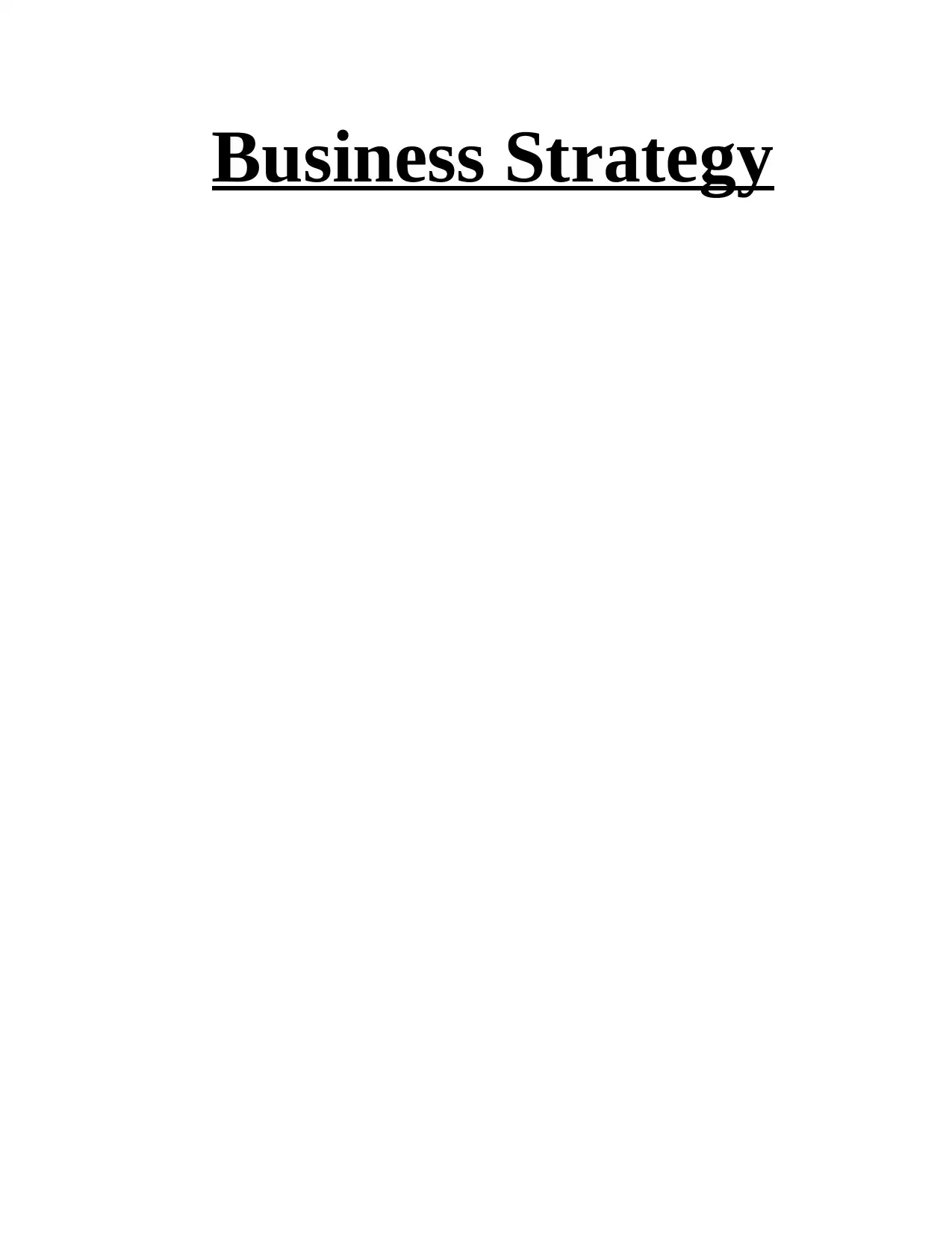
Business Strategy
Secure Best Marks with AI Grader
Need help grading? Try our AI Grader for instant feedback on your assignments.
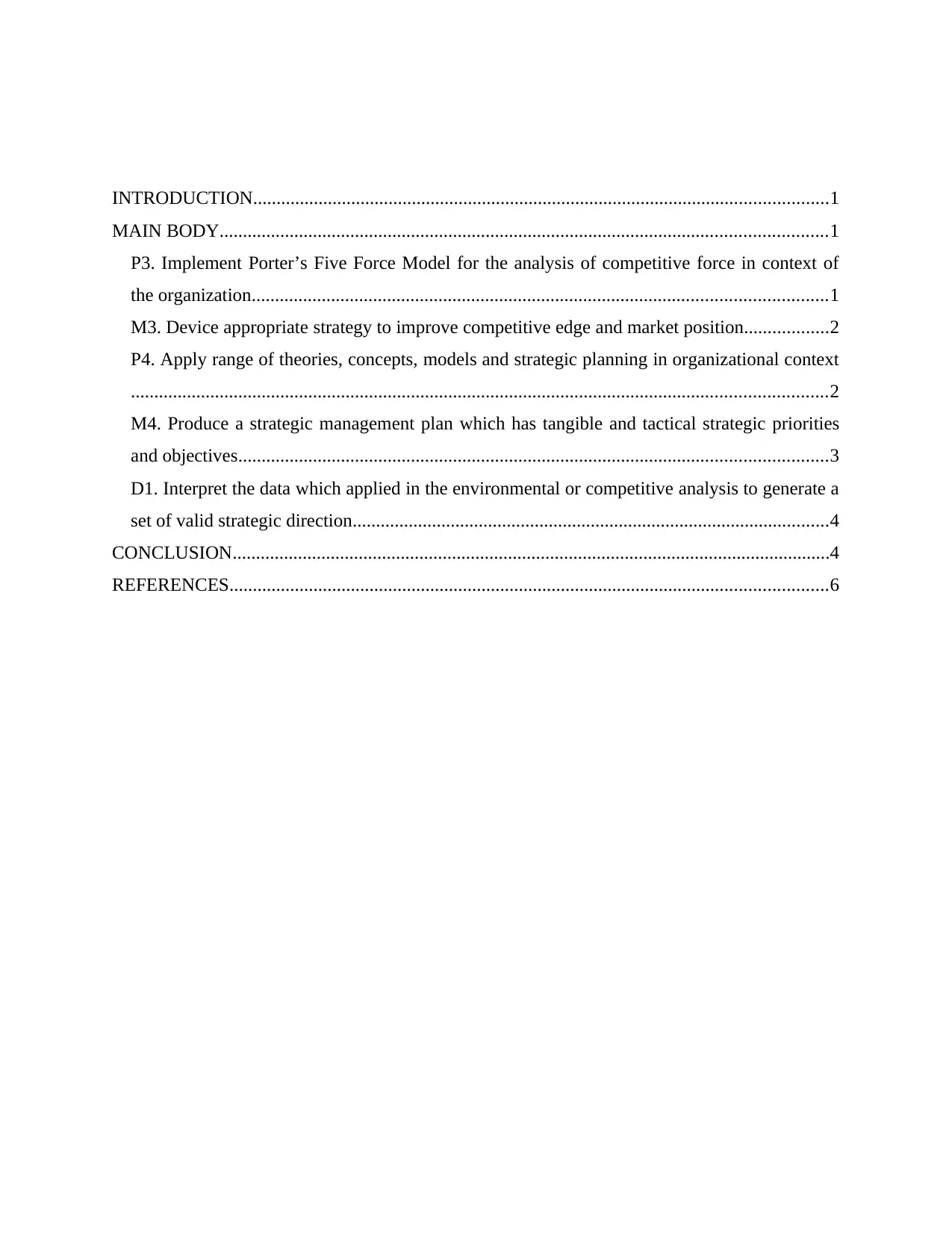
INTRODUCTION...........................................................................................................................1
MAIN BODY..................................................................................................................................1
P3. Implement Porter’s Five Force Model for the analysis of competitive force in context of
the organization...........................................................................................................................1
M3. Device appropriate strategy to improve competitive edge and market position..................2
P4. Apply range of theories, concepts, models and strategic planning in organizational context
.....................................................................................................................................................2
M4. Produce a strategic management plan which has tangible and tactical strategic priorities
and objectives..............................................................................................................................3
D1. Interpret the data which applied in the environmental or competitive analysis to generate a
set of valid strategic direction......................................................................................................4
CONCLUSION................................................................................................................................4
REFERENCES................................................................................................................................6
MAIN BODY..................................................................................................................................1
P3. Implement Porter’s Five Force Model for the analysis of competitive force in context of
the organization...........................................................................................................................1
M3. Device appropriate strategy to improve competitive edge and market position..................2
P4. Apply range of theories, concepts, models and strategic planning in organizational context
.....................................................................................................................................................2
M4. Produce a strategic management plan which has tangible and tactical strategic priorities
and objectives..............................................................................................................................3
D1. Interpret the data which applied in the environmental or competitive analysis to generate a
set of valid strategic direction......................................................................................................4
CONCLUSION................................................................................................................................4
REFERENCES................................................................................................................................6
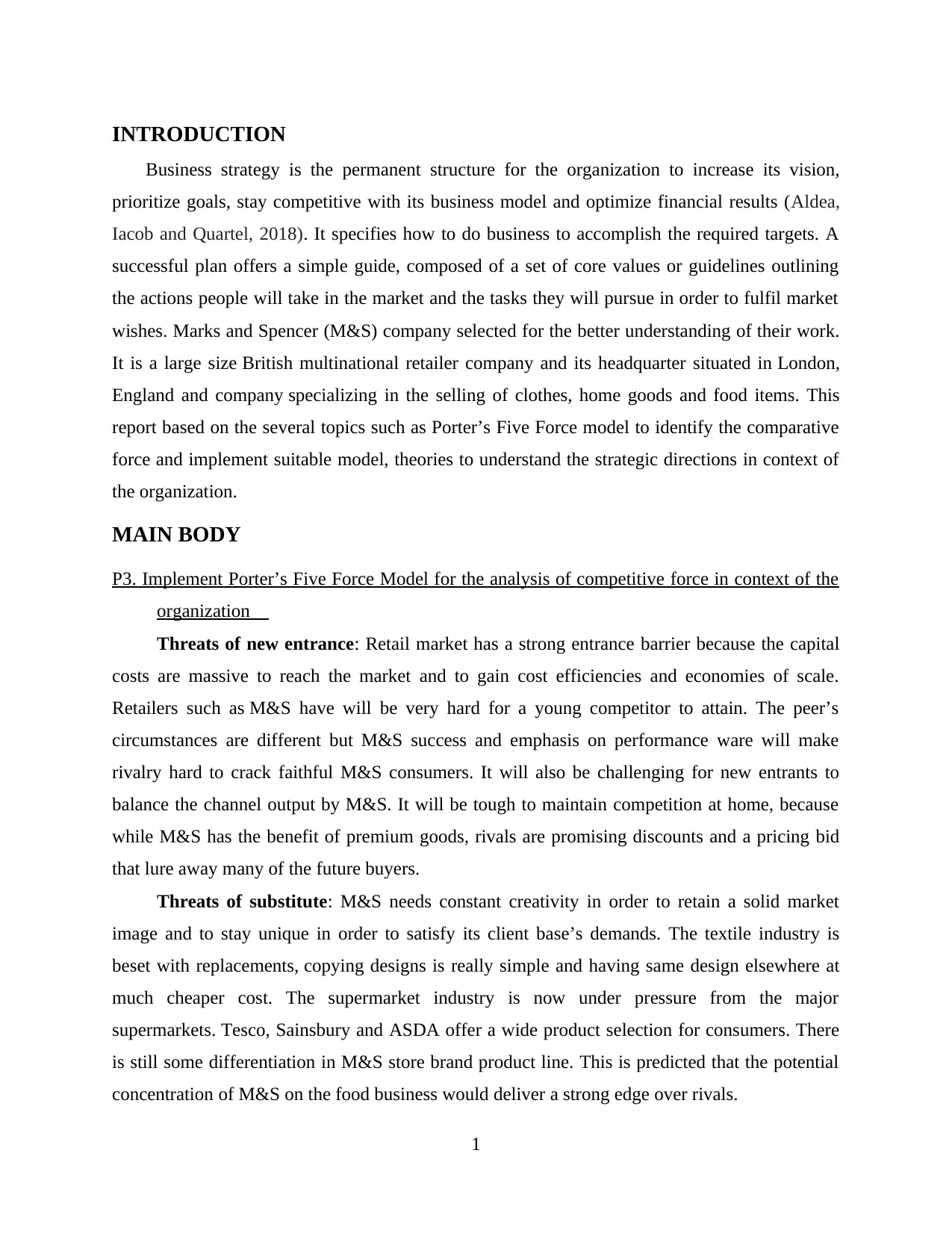
INTRODUCTION
Business strategy is the permanent structure for the organization to increase its vision,
prioritize goals, stay competitive with its business model and optimize financial results (Aldea,
Iacob and Quartel, 2018). It specifies how to do business to accomplish the required targets. A
successful plan offers a simple guide, composed of a set of core values or guidelines outlining
the actions people will take in the market and the tasks they will pursue in order to fulfil market
wishes. Marks and Spencer (M&S) company selected for the better understanding of their work.
It is a large size British multinational retailer company and its headquarter situated in London,
England and company specializing in the selling of clothes, home goods and food items. This
report based on the several topics such as Porter’s Five Force model to identify the comparative
force and implement suitable model, theories to understand the strategic directions in context of
the organization.
MAIN BODY
P3. Implement Porter’s Five Force Model for the analysis of competitive force in context of the
organization
Threats of new entrance: Retail market has a strong entrance barrier because the capital
costs are massive to reach the market and to gain cost efficiencies and economies of scale.
Retailers such as M&S have will be very hard for a young competitor to attain. The peer’s
circumstances are different but M&S success and emphasis on performance ware will make
rivalry hard to crack faithful M&S consumers. It will also be challenging for new entrants to
balance the channel output by M&S. It will be tough to maintain competition at home, because
while M&S has the benefit of premium goods, rivals are promising discounts and a pricing bid
that lure away many of the future buyers.
Threats of substitute: M&S needs constant creativity in order to retain a solid market
image and to stay unique in order to satisfy its client base’s demands. The textile industry is
beset with replacements, copying designs is really simple and having same design elsewhere at
much cheaper cost. The supermarket industry is now under pressure from the major
supermarkets. Tesco, Sainsbury and ASDA offer a wide product selection for consumers. There
is still some differentiation in M&S store brand product line. This is predicted that the potential
concentration of M&S on the food business would deliver a strong edge over rivals.
1
Business strategy is the permanent structure for the organization to increase its vision,
prioritize goals, stay competitive with its business model and optimize financial results (Aldea,
Iacob and Quartel, 2018). It specifies how to do business to accomplish the required targets. A
successful plan offers a simple guide, composed of a set of core values or guidelines outlining
the actions people will take in the market and the tasks they will pursue in order to fulfil market
wishes. Marks and Spencer (M&S) company selected for the better understanding of their work.
It is a large size British multinational retailer company and its headquarter situated in London,
England and company specializing in the selling of clothes, home goods and food items. This
report based on the several topics such as Porter’s Five Force model to identify the comparative
force and implement suitable model, theories to understand the strategic directions in context of
the organization.
MAIN BODY
P3. Implement Porter’s Five Force Model for the analysis of competitive force in context of the
organization
Threats of new entrance: Retail market has a strong entrance barrier because the capital
costs are massive to reach the market and to gain cost efficiencies and economies of scale.
Retailers such as M&S have will be very hard for a young competitor to attain. The peer’s
circumstances are different but M&S success and emphasis on performance ware will make
rivalry hard to crack faithful M&S consumers. It will also be challenging for new entrants to
balance the channel output by M&S. It will be tough to maintain competition at home, because
while M&S has the benefit of premium goods, rivals are promising discounts and a pricing bid
that lure away many of the future buyers.
Threats of substitute: M&S needs constant creativity in order to retain a solid market
image and to stay unique in order to satisfy its client base’s demands. The textile industry is
beset with replacements, copying designs is really simple and having same design elsewhere at
much cheaper cost. The supermarket industry is now under pressure from the major
supermarkets. Tesco, Sainsbury and ASDA offer a wide product selection for consumers. There
is still some differentiation in M&S store brand product line. This is predicted that the potential
concentration of M&S on the food business would deliver a strong edge over rivals.
1
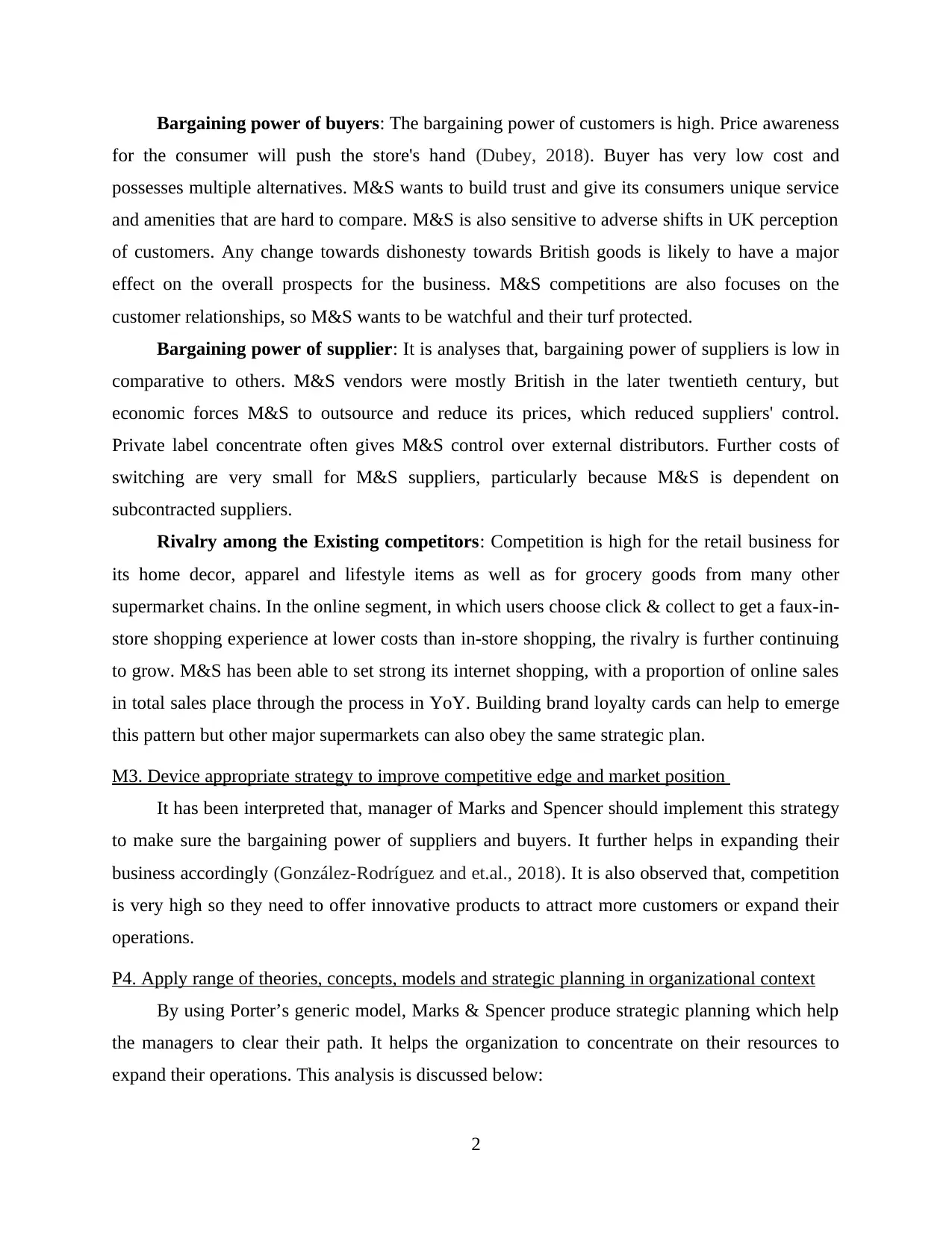
Bargaining power of buyers: The bargaining power of customers is high. Price awareness
for the consumer will push the store's hand (Dubey, 2018). Buyer has very low cost and
possesses multiple alternatives. M&S wants to build trust and give its consumers unique service
and amenities that are hard to compare. M&S is also sensitive to adverse shifts in UK perception
of customers. Any change towards dishonesty towards British goods is likely to have a major
effect on the overall prospects for the business. M&S competitions are also focuses on the
customer relationships, so M&S wants to be watchful and their turf protected.
Bargaining power of supplier: It is analyses that, bargaining power of suppliers is low in
comparative to others. M&S vendors were mostly British in the later twentieth century, but
economic forces M&S to outsource and reduce its prices, which reduced suppliers' control.
Private label concentrate often gives M&S control over external distributors. Further costs of
switching are very small for M&S suppliers, particularly because M&S is dependent on
subcontracted suppliers.
Rivalry among the Existing competitors: Competition is high for the retail business for
its home decor, apparel and lifestyle items as well as for grocery goods from many other
supermarket chains. In the online segment, in which users choose click & collect to get a faux-in-
store shopping experience at lower costs than in-store shopping, the rivalry is further continuing
to grow. M&S has been able to set strong its internet shopping, with a proportion of online sales
in total sales place through the process in YoY. Building brand loyalty cards can help to emerge
this pattern but other major supermarkets can also obey the same strategic plan.
M3. Device appropriate strategy to improve competitive edge and market position
It has been interpreted that, manager of Marks and Spencer should implement this strategy
to make sure the bargaining power of suppliers and buyers. It further helps in expanding their
business accordingly (González-Rodríguez and et.al., 2018). It is also observed that, competition
is very high so they need to offer innovative products to attract more customers or expand their
operations.
P4. Apply range of theories, concepts, models and strategic planning in organizational context
By using Porter’s generic model, Marks & Spencer produce strategic planning which help
the managers to clear their path. It helps the organization to concentrate on their resources to
expand their operations. This analysis is discussed below:
2
for the consumer will push the store's hand (Dubey, 2018). Buyer has very low cost and
possesses multiple alternatives. M&S wants to build trust and give its consumers unique service
and amenities that are hard to compare. M&S is also sensitive to adverse shifts in UK perception
of customers. Any change towards dishonesty towards British goods is likely to have a major
effect on the overall prospects for the business. M&S competitions are also focuses on the
customer relationships, so M&S wants to be watchful and their turf protected.
Bargaining power of supplier: It is analyses that, bargaining power of suppliers is low in
comparative to others. M&S vendors were mostly British in the later twentieth century, but
economic forces M&S to outsource and reduce its prices, which reduced suppliers' control.
Private label concentrate often gives M&S control over external distributors. Further costs of
switching are very small for M&S suppliers, particularly because M&S is dependent on
subcontracted suppliers.
Rivalry among the Existing competitors: Competition is high for the retail business for
its home decor, apparel and lifestyle items as well as for grocery goods from many other
supermarket chains. In the online segment, in which users choose click & collect to get a faux-in-
store shopping experience at lower costs than in-store shopping, the rivalry is further continuing
to grow. M&S has been able to set strong its internet shopping, with a proportion of online sales
in total sales place through the process in YoY. Building brand loyalty cards can help to emerge
this pattern but other major supermarkets can also obey the same strategic plan.
M3. Device appropriate strategy to improve competitive edge and market position
It has been interpreted that, manager of Marks and Spencer should implement this strategy
to make sure the bargaining power of suppliers and buyers. It further helps in expanding their
business accordingly (González-Rodríguez and et.al., 2018). It is also observed that, competition
is very high so they need to offer innovative products to attract more customers or expand their
operations.
P4. Apply range of theories, concepts, models and strategic planning in organizational context
By using Porter’s generic model, Marks & Spencer produce strategic planning which help
the managers to clear their path. It helps the organization to concentrate on their resources to
expand their operations. This analysis is discussed below:
2
Secure Best Marks with AI Grader
Need help grading? Try our AI Grader for instant feedback on your assignments.
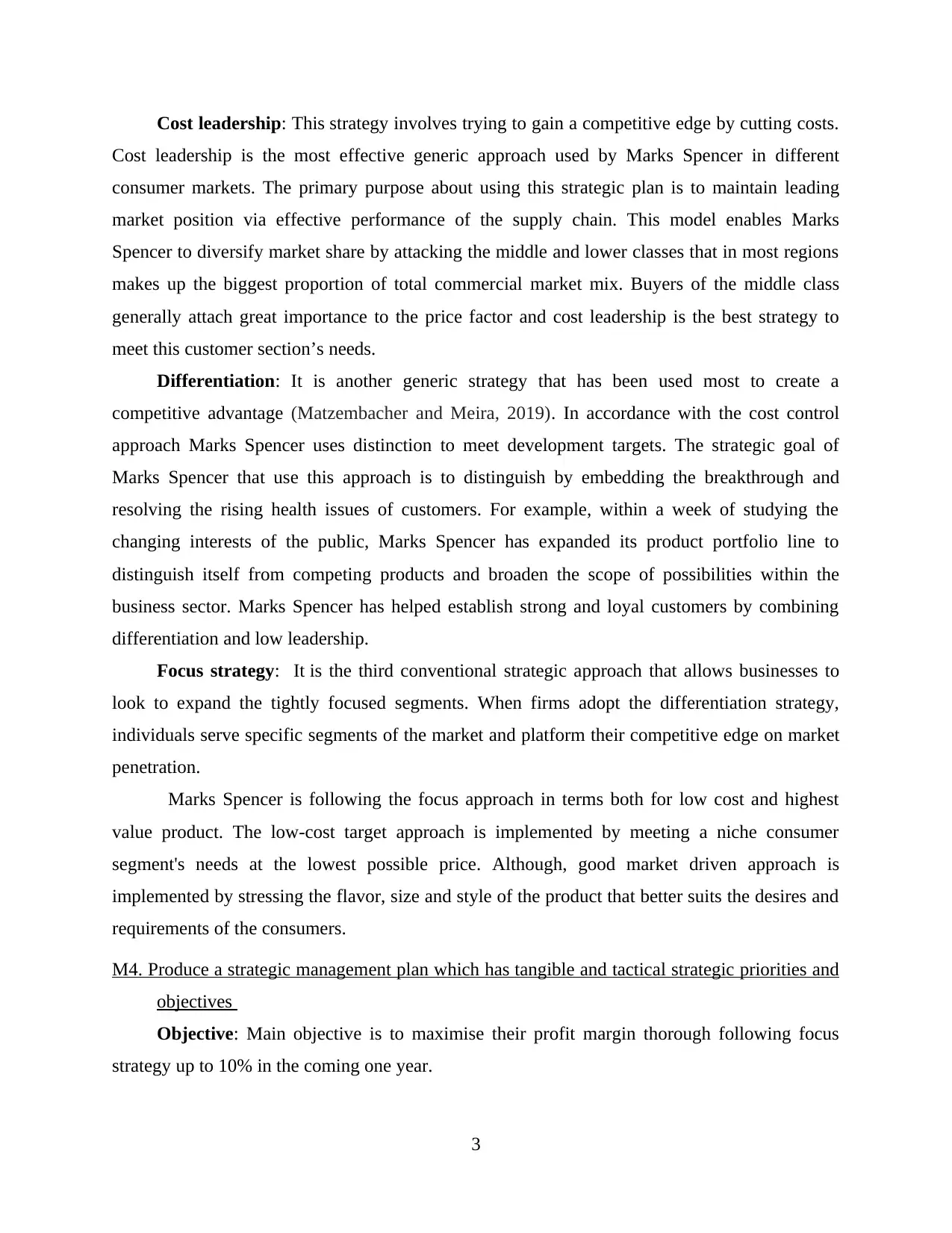
Cost leadership: This strategy involves trying to gain a competitive edge by cutting costs.
Cost leadership is the most effective generic approach used by Marks Spencer in different
consumer markets. The primary purpose about using this strategic plan is to maintain leading
market position via effective performance of the supply chain. This model enables Marks
Spencer to diversify market share by attacking the middle and lower classes that in most regions
makes up the biggest proportion of total commercial market mix. Buyers of the middle class
generally attach great importance to the price factor and cost leadership is the best strategy to
meet this customer section’s needs.
Differentiation: It is another generic strategy that has been used most to create a
competitive advantage (Matzembacher and Meira, 2019). In accordance with the cost control
approach Marks Spencer uses distinction to meet development targets. The strategic goal of
Marks Spencer that use this approach is to distinguish by embedding the breakthrough and
resolving the rising health issues of customers. For example, within a week of studying the
changing interests of the public, Marks Spencer has expanded its product portfolio line to
distinguish itself from competing products and broaden the scope of possibilities within the
business sector. Marks Spencer has helped establish strong and loyal customers by combining
differentiation and low leadership.
Focus strategy: It is the third conventional strategic approach that allows businesses to
look to expand the tightly focused segments. When firms adopt the differentiation strategy,
individuals serve specific segments of the market and platform their competitive edge on market
penetration.
Marks Spencer is following the focus approach in terms both for low cost and highest
value product. The low-cost target approach is implemented by meeting a niche consumer
segment's needs at the lowest possible price. Although, good market driven approach is
implemented by stressing the flavor, size and style of the product that better suits the desires and
requirements of the consumers.
M4. Produce a strategic management plan which has tangible and tactical strategic priorities and
objectives
Objective: Main objective is to maximise their profit margin thorough following focus
strategy up to 10% in the coming one year.
3
Cost leadership is the most effective generic approach used by Marks Spencer in different
consumer markets. The primary purpose about using this strategic plan is to maintain leading
market position via effective performance of the supply chain. This model enables Marks
Spencer to diversify market share by attacking the middle and lower classes that in most regions
makes up the biggest proportion of total commercial market mix. Buyers of the middle class
generally attach great importance to the price factor and cost leadership is the best strategy to
meet this customer section’s needs.
Differentiation: It is another generic strategy that has been used most to create a
competitive advantage (Matzembacher and Meira, 2019). In accordance with the cost control
approach Marks Spencer uses distinction to meet development targets. The strategic goal of
Marks Spencer that use this approach is to distinguish by embedding the breakthrough and
resolving the rising health issues of customers. For example, within a week of studying the
changing interests of the public, Marks Spencer has expanded its product portfolio line to
distinguish itself from competing products and broaden the scope of possibilities within the
business sector. Marks Spencer has helped establish strong and loyal customers by combining
differentiation and low leadership.
Focus strategy: It is the third conventional strategic approach that allows businesses to
look to expand the tightly focused segments. When firms adopt the differentiation strategy,
individuals serve specific segments of the market and platform their competitive edge on market
penetration.
Marks Spencer is following the focus approach in terms both for low cost and highest
value product. The low-cost target approach is implemented by meeting a niche consumer
segment's needs at the lowest possible price. Although, good market driven approach is
implemented by stressing the flavor, size and style of the product that better suits the desires and
requirements of the consumers.
M4. Produce a strategic management plan which has tangible and tactical strategic priorities and
objectives
Objective: Main objective is to maximise their profit margin thorough following focus
strategy up to 10% in the coming one year.
3
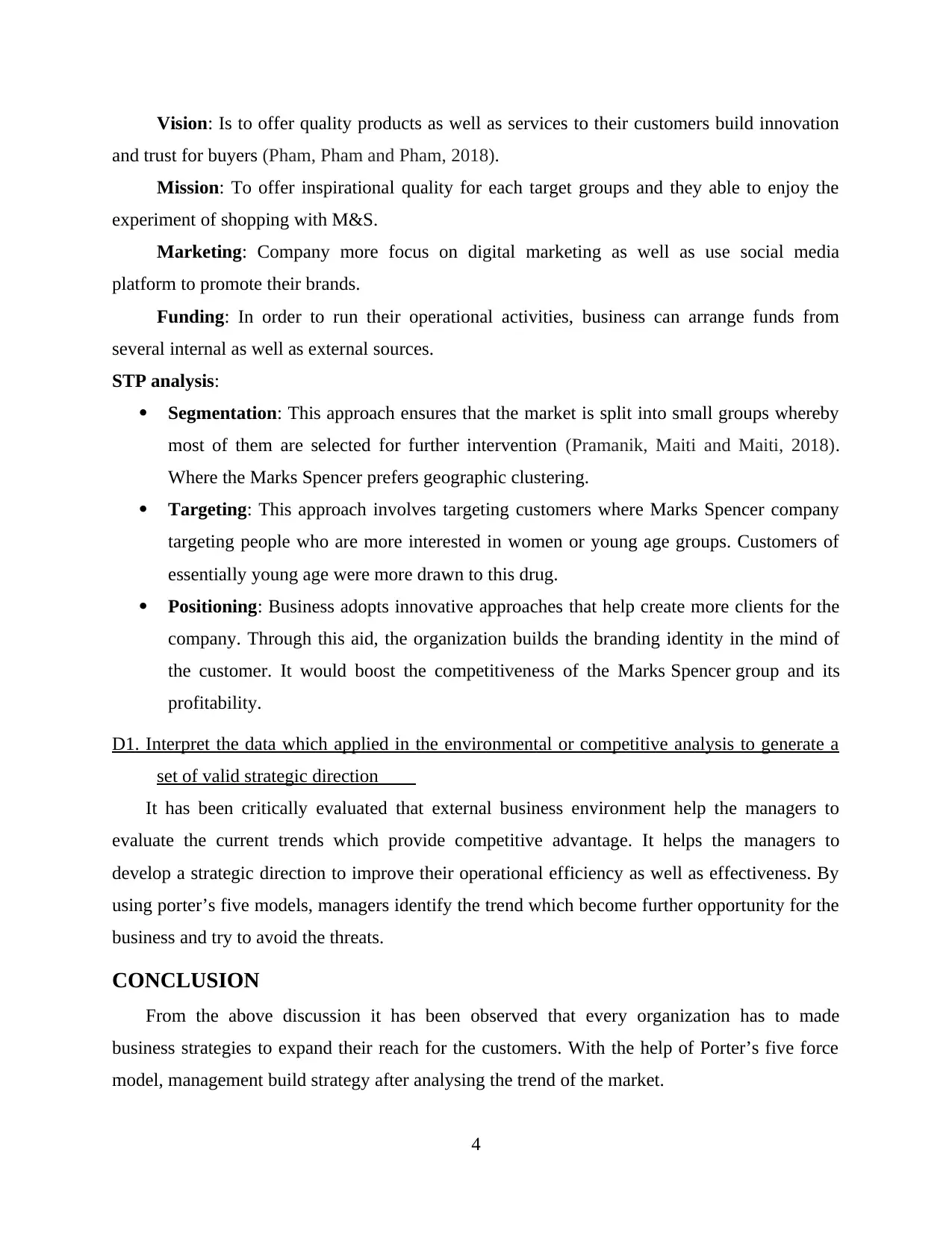
Vision: Is to offer quality products as well as services to their customers build innovation
and trust for buyers (Pham, Pham and Pham, 2018).
Mission: To offer inspirational quality for each target groups and they able to enjoy the
experiment of shopping with M&S.
Marketing: Company more focus on digital marketing as well as use social media
platform to promote their brands.
Funding: In order to run their operational activities, business can arrange funds from
several internal as well as external sources.
STP analysis:
Segmentation: This approach ensures that the market is split into small groups whereby
most of them are selected for further intervention (Pramanik, Maiti and Maiti, 2018).
Where the Marks Spencer prefers geographic clustering.
Targeting: This approach involves targeting customers where Marks Spencer company
targeting people who are more interested in women or young age groups. Customers of
essentially young age were more drawn to this drug.
Positioning: Business adopts innovative approaches that help create more clients for the
company. Through this aid, the organization builds the branding identity in the mind of
the customer. It would boost the competitiveness of the Marks Spencer group and its
profitability.
D1. Interpret the data which applied in the environmental or competitive analysis to generate a
set of valid strategic direction
It has been critically evaluated that external business environment help the managers to
evaluate the current trends which provide competitive advantage. It helps the managers to
develop a strategic direction to improve their operational efficiency as well as effectiveness. By
using porter’s five models, managers identify the trend which become further opportunity for the
business and try to avoid the threats.
CONCLUSION
From the above discussion it has been observed that every organization has to made
business strategies to expand their reach for the customers. With the help of Porter’s five force
model, management build strategy after analysing the trend of the market.
4
and trust for buyers (Pham, Pham and Pham, 2018).
Mission: To offer inspirational quality for each target groups and they able to enjoy the
experiment of shopping with M&S.
Marketing: Company more focus on digital marketing as well as use social media
platform to promote their brands.
Funding: In order to run their operational activities, business can arrange funds from
several internal as well as external sources.
STP analysis:
Segmentation: This approach ensures that the market is split into small groups whereby
most of them are selected for further intervention (Pramanik, Maiti and Maiti, 2018).
Where the Marks Spencer prefers geographic clustering.
Targeting: This approach involves targeting customers where Marks Spencer company
targeting people who are more interested in women or young age groups. Customers of
essentially young age were more drawn to this drug.
Positioning: Business adopts innovative approaches that help create more clients for the
company. Through this aid, the organization builds the branding identity in the mind of
the customer. It would boost the competitiveness of the Marks Spencer group and its
profitability.
D1. Interpret the data which applied in the environmental or competitive analysis to generate a
set of valid strategic direction
It has been critically evaluated that external business environment help the managers to
evaluate the current trends which provide competitive advantage. It helps the managers to
develop a strategic direction to improve their operational efficiency as well as effectiveness. By
using porter’s five models, managers identify the trend which become further opportunity for the
business and try to avoid the threats.
CONCLUSION
From the above discussion it has been observed that every organization has to made
business strategies to expand their reach for the customers. With the help of Porter’s five force
model, management build strategy after analysing the trend of the market.
4

5
Paraphrase This Document
Need a fresh take? Get an instant paraphrase of this document with our AI Paraphraser
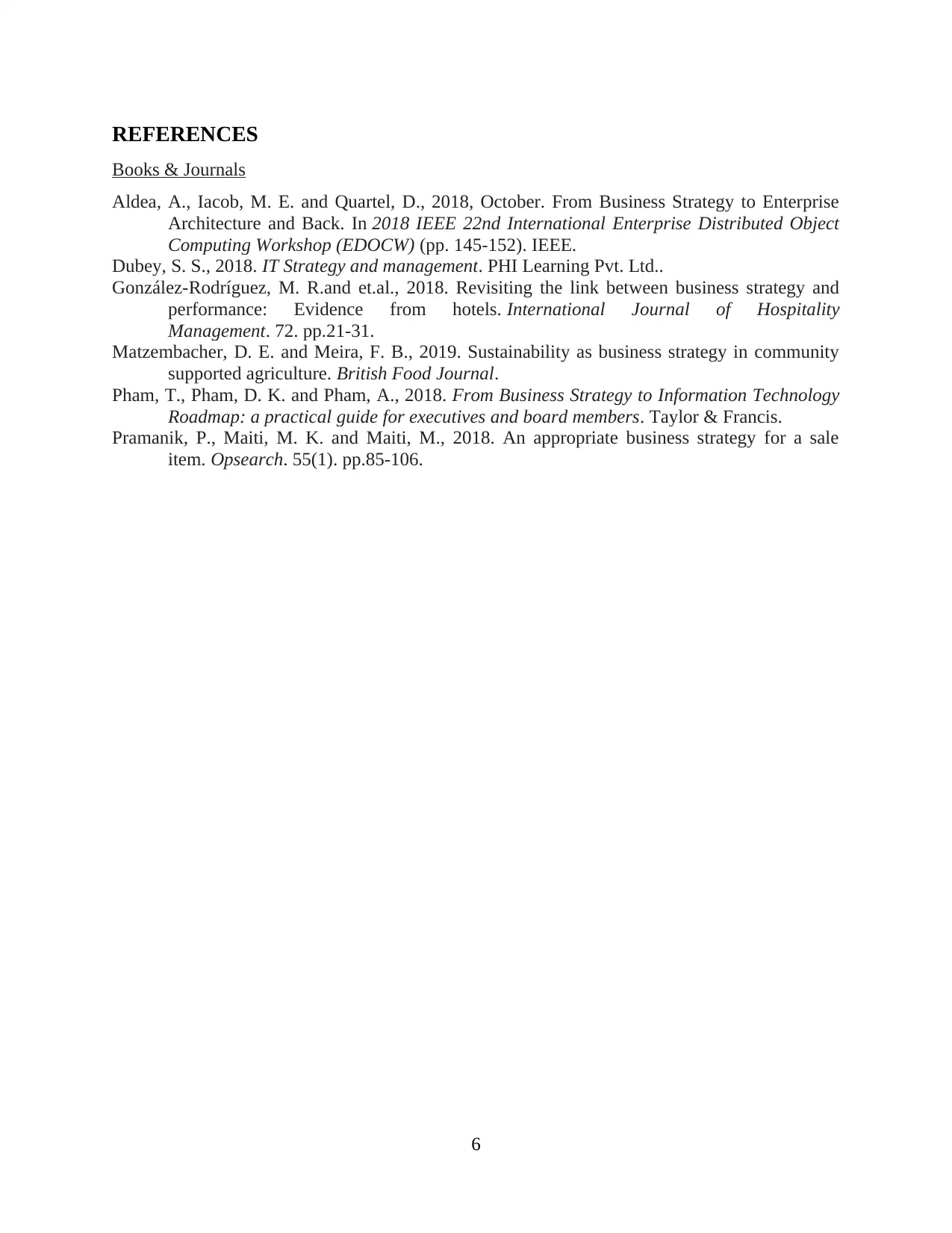
REFERENCES
Books & Journals
Aldea, A., Iacob, M. E. and Quartel, D., 2018, October. From Business Strategy to Enterprise
Architecture and Back. In 2018 IEEE 22nd International Enterprise Distributed Object
Computing Workshop (EDOCW) (pp. 145-152). IEEE.
Dubey, S. S., 2018. IT Strategy and management. PHI Learning Pvt. Ltd..
González-Rodríguez, M. R.and et.al., 2018. Revisiting the link between business strategy and
performance: Evidence from hotels. International Journal of Hospitality
Management. 72. pp.21-31.
Matzembacher, D. E. and Meira, F. B., 2019. Sustainability as business strategy in community
supported agriculture. British Food Journal.
Pham, T., Pham, D. K. and Pham, A., 2018. From Business Strategy to Information Technology
Roadmap: a practical guide for executives and board members. Taylor & Francis.
Pramanik, P., Maiti, M. K. and Maiti, M., 2018. An appropriate business strategy for a sale
item. Opsearch. 55(1). pp.85-106.
6
Books & Journals
Aldea, A., Iacob, M. E. and Quartel, D., 2018, October. From Business Strategy to Enterprise
Architecture and Back. In 2018 IEEE 22nd International Enterprise Distributed Object
Computing Workshop (EDOCW) (pp. 145-152). IEEE.
Dubey, S. S., 2018. IT Strategy and management. PHI Learning Pvt. Ltd..
González-Rodríguez, M. R.and et.al., 2018. Revisiting the link between business strategy and
performance: Evidence from hotels. International Journal of Hospitality
Management. 72. pp.21-31.
Matzembacher, D. E. and Meira, F. B., 2019. Sustainability as business strategy in community
supported agriculture. British Food Journal.
Pham, T., Pham, D. K. and Pham, A., 2018. From Business Strategy to Information Technology
Roadmap: a practical guide for executives and board members. Taylor & Francis.
Pramanik, P., Maiti, M. K. and Maiti, M., 2018. An appropriate business strategy for a sale
item. Opsearch. 55(1). pp.85-106.
6
1 out of 8
Related Documents
Your All-in-One AI-Powered Toolkit for Academic Success.
+13062052269
info@desklib.com
Available 24*7 on WhatsApp / Email
![[object Object]](/_next/static/media/star-bottom.7253800d.svg)
Unlock your academic potential
© 2024 | Zucol Services PVT LTD | All rights reserved.




